The sun was just barely visible in the horizon, warming the cool desert region around Granada as we dashed our way through town from the Hostal Olympia to the train station. There was a spring in our steps from a great night’s rest, and we found ourselves with time to spare from the two-kilometer walk. We each had a Café con lache, (half coffee half steamed milk) which we have become accustomed to in the mornings since our arrival in Spain some ten days ago. I was looking forward to seeing the beautiful terrain of this desert landscape once again as we had driven through it the day before, making our way from the small town of Bobadilla eastward to Granada. Since the cameras were well stowed the last time, we were unable to capture it on film or should I say digitally (the latter just does not have the same romantic ring). But today with my camera in hand and being on a first class train heading westwardly to Sevilla, I was ready. Since the train was moving rather quickly, it was hard to capture the majestic nature of this place, there is peacefulness to it all despite the barren appearance of the landscape. The countryside was full of olive plantations. It was only later that we found out that the province of Andalucia produces the most olive oil in the world. No other place in the world has more olive trees, with close to 1.5 million hectares and an average production of over 800,000 metric tons of Spanish olive oil (approximately a third of the global olive oil market). As the train whistled by the semideserts, lush river valleys and gorge-riddled mountains, I gazed through the window enjoying the marvelous scenery, while Rav was pensive in her demeanor, contemplating about the flamenco dancing and the bull fighting that Seville is famous for. Two of the things we had wanted to see the most in all of Spain was going to take place in a matter of days.
 The mountainous gorges and lush greenery of Andalucia
The mountainous gorges and lush greenery of Andalucia
 The olive plantations in the semidesert conditions
The olive plantations in the semidesert conditions Chris enjoying the scenery of Andalucia
Chris enjoying the scenery of AndaluciaThe three and a half hour trip went by rather quickly and we found ourselves standing in front of the tourist office waiting in line to book a hotel/hostal for our stint in Seville. We ended up booking at the Santa Maria Hostal just 50 meters away from the Cathedral in the center of town for 45 Euros a night with our own private bathroom and air conditioning (the latter was a god send as the mid afternoon here in Seville is blistering hot). From what we can tell the owner of the Hostal is an elderly woman in her eighties who calls the shots, while two younger ladies are responsible for the cleaning. The rooms are clean but the place can be a bit noisy being so close to the Cathedral with the constant sounds of church bells and door bells from other patrons. We also booked a flamenco show at the famous El Palacio Andaluz for that evening.
The first afternoon was spent looking for the Plaza de Toros de la Real Maestranza – where the bullfights take place. We had heard and read that the bullfights are very popular, and that they sell out rather quickly. So we braved the burning afternoon sun and sauntered through the construction ridden streets and cobble stone alleyways to make our way to the bullfighting arena. We arrived there just before 3 p.m.only to find out that the office does not open until 6 p.m. It was disappointing to come all that way only to be denied. Like a wounded matador we headed away from the arena to enjoy some of the other fine things in Seville.
 Rav enjoying all of the tapas… especially the squid in it’s own black ink…NOT!
Rav enjoying all of the tapas… especially the squid in it’s own black ink…NOT! No no you eat… I’ll just sit here and watch.
No no you eat… I’ll just sit here and watch.That evening we took in a flamenco show, which was a great introduction into the city of Seville. Flamenco is an art form, a way of life so it would seem. A mixture of gypsy and andalusian culture and has a strong influence from the Arabic culture, which is also reflected in the architectural styles that defines Spanish architecture (more on this later). The emotions and passion that the dancers express in conjunction with the classical guitars and the associated soulful melodies of the singers, along with the colourful costumes make this quite the experience for the senses. Adding to that the dry rose wine and a stiff rye and coke - you get the taste buds dancing as well. We thoroughly enjoyed the hour and a half long show and were impressed with all of the performers.
 An instrument of art
An instrument of art One of the 6 male performers dancing his heart out. Made us think about the dancer we saw in Barcelona for a measly 5 Euros
One of the 6 male performers dancing his heart out. Made us think about the dancer we saw in Barcelona for a measly 5 Euros A dance of two lovers
A dance of two lovers The classic flamenco pose
The classic flamenco pose Another passionate dance
Another passionate danceWe were both exhausted just watching the performers and were not looking forward to the 45 minute walk back to the hostal. But the next day was a full day – filled with site seeing and the bullfight in the evening. Should be a good one!
Seville is a small city with a little over 700,000 people where the cobble stone streets are tiny and windy, with numerous plazas and horse drawn carriages along orange trees that line the streets. The scorching sun means the alleyways are covered with fabric to provide shade for the pedestrians and tourists alike. The constant ringing of church bells and the flip flopping of horse hooves make this feel like a medieval town rather than a city of the 21st century despite the fact that some of the major boulevards are ripped up for the addition of a new tram system. It was easy to get around if you have a good map because the windy roads can lead you in the wrong path rather quickly. With that in mind we set off to discover the sites of Seville.

A typical street with fabric coverings to block out the sun One of the many alleyways that are less than 2 meters wide. This will not meet code in Vancouver
One of the many alleyways that are less than 2 meters wide. This will not meet code in Vancouver The most visited monument in Seville today which was built for the exposition in 1929 . This 200 meter semi circle with it’s twin towers at each end is quite a magnificent building. The building facades are covered with ceramics as remnants of the Muslim roots established in this region, between the 12th to the 14th centuries. Although some of the areas were in a state of decay, the overall appearance of the building still has an impressive presence. Plaza de Espana – from the terrace within the plaza. You can see the semicircular shape here
The most visited monument in Seville today which was built for the exposition in 1929 . This 200 meter semi circle with it’s twin towers at each end is quite a magnificent building. The building facades are covered with ceramics as remnants of the Muslim roots established in this region, between the 12th to the 14th centuries. Although some of the areas were in a state of decay, the overall appearance of the building still has an impressive presence. Plaza de Espana – from the terrace within the plaza. You can see the semicircular shape here The opposite tower as seen from the other side
The opposite tower as seen from the other side Rav sun tanning between one of the many columns that hold up the building
Rav sun tanning between one of the many columns that hold up the building The west tower through the ceramic covered ballads
The west tower through the ceramic covered ballads Us at the Plaza de Espana
Us at the Plaza de Espana Archeology museum
Archeology museum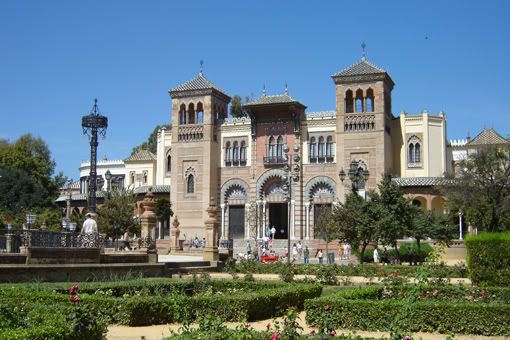 Museum of folk art and customs
Museum of folk art and customs One of the more modern bridges in Seville
One of the more modern bridges in Seville The Alamilo Bridge
The Alamilo Bridge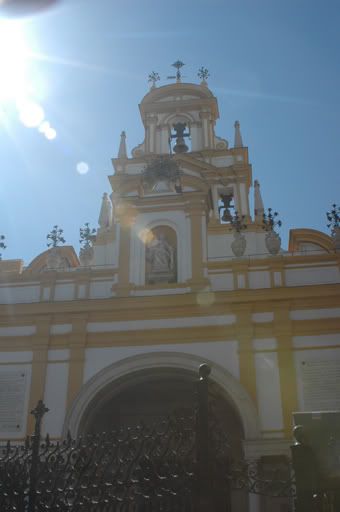 Basilica of the Macarena from the outside
Basilica of the Macarena from the outside The Virgin Mary at the main alter of the Basilica of the Macarena
The Virgin Mary at the main alter of the Basilica of the Macarena The Cathedral
The Cathedral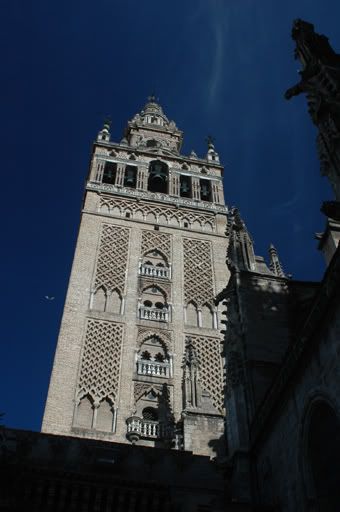 Built on the site of a Muslim mosque the Giralda was once one of the tallest towers in the world. We did get a chance to climb to the bell towers for a good look at the city below. Although this tower has gone through many architectural styles over the course of time and conquerors, it still has a profound impact on the observer
Built on the site of a Muslim mosque the Giralda was once one of the tallest towers in the world. We did get a chance to climb to the bell towers for a good look at the city below. Although this tower has gone through many architectural styles over the course of time and conquerors, it still has a profound impact on the observer The last addition was that of the Renaissance style as seen here with a small dome topped off with a wind vane, the Giraldillo
The last addition was that of the Renaissance style as seen here with a small dome topped off with a wind vane, the Giraldillo The Cathedral occupies the site of a great mosque built in the late 12th century and still maintains the bell tower known as the Giralda. This is the largest gothic temple in the world and the third largest Christian Cathedral following only St. Peters in Rome and St. Paul in England
The Cathedral occupies the site of a great mosque built in the late 12th century and still maintains the bell tower known as the Giralda. This is the largest gothic temple in the world and the third largest Christian Cathedral following only St. Peters in Rome and St. Paul in England The Cathedral is made up of 5 naves each with exquisite artistic treasures, with the main altarpiece regarded as one of the greatest in the Christian world
The Cathedral is made up of 5 naves each with exquisite artistic treasures, with the main altarpiece regarded as one of the greatest in the Christian world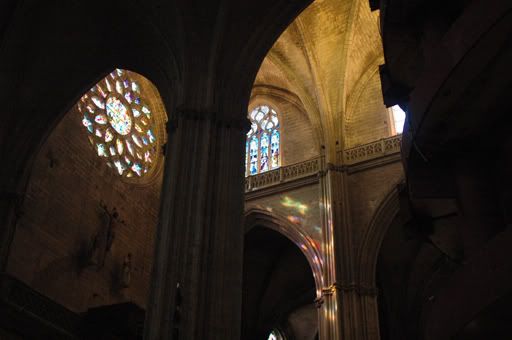 The sunlight shining through the Rosary illuminating the main alter piece
The sunlight shining through the Rosary illuminating the main alter piece An ornate carving at the gate to the Cathedral illustrating the Muslim origin and influence
An ornate carving at the gate to the Cathedral illustrating the Muslim origin and influence Seville through its Cathedral also pays homage to Christopher Columbus. Rumor has it that his body is laid to rest here, but carbon dating states otherwise
Seville through its Cathedral also pays homage to Christopher Columbus. Rumor has it that his body is laid to rest here, but carbon dating states otherwiseWe ventured from here to the Torre del Oro – the golden tower as it is also known. One of the last examples of Moorish architecture was built as a defensive tower in the 12th century but now houses the naval museum. Stories have it that gold and silver were stored here from ships coming from the Americas back in the day, but we could not see any evidence of that.
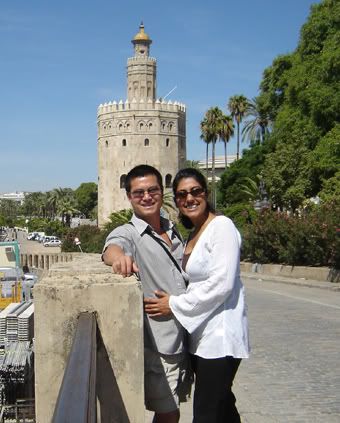 Us at the entrance to the Torres del Oro
Us at the entrance to the Torres del Oro 500 meter away from the Torres del Oro is the Plaza de Toros de la Real Maestranza – better known to us as the bull ring. Construction started in 1761 and ended in 1881. Its exterior shows the style of the Late Baroque and early Classical periods
500 meter away from the Torres del Oro is the Plaza de Toros de la Real Maestranza – better known to us as the bull ring. Construction started in 1761 and ended in 1881. Its exterior shows the style of the Late Baroque and early Classical periodsInside the bullring, its museum houses exhibits related to the history and order of the owners of the ring. We skipped this and went straight to see the match. With our 10.50 Euro tickets in hand, we headed for our seats that were in the direct sun light. Just imagine sitting on bricks that have been baking in the sun all day. The intense heat was unbearable, but once the match started we hardly paid any attention to the sun.
 The interior of the bullring
The interior of the bullring The Matadors… there are certainly a lot of them. Bull fighting is certainly not an individual sport as there are three stages to the match. The first two involve a team of men both on horseback and on foot, aimed at progressively weakening the bull. The third stage comes the matador to finish the job. It hardly seems fair
The Matadors… there are certainly a lot of them. Bull fighting is certainly not an individual sport as there are three stages to the match. The first two involve a team of men both on horseback and on foot, aimed at progressively weakening the bull. The third stage comes the matador to finish the job. It hardly seems fair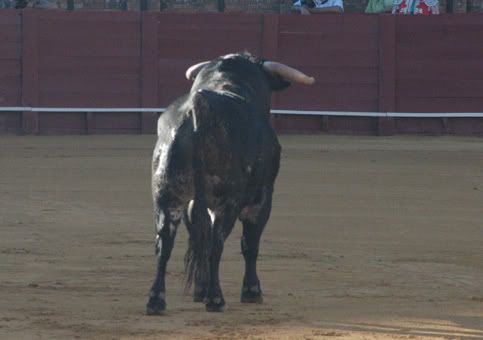 And only one Bull?…In total 6 bulls fell that night. The bulls are bred for courage and aggression, enjoying a full life prior to its time in the ring. Bull must be at least 4 years old before they can fight
And only one Bull?…In total 6 bulls fell that night. The bulls are bred for courage and aggression, enjoying a full life prior to its time in the ring. Bull must be at least 4 years old before they can fight What the heck are these colourful things on me? These are actually called banderillas – barbed darts designed to be driven into the back muscles of the bull to weaken them
What the heck are these colourful things on me? These are actually called banderillas – barbed darts designed to be driven into the back muscles of the bull to weaken them I’ll show you my horns if you show me yours! “Ole`!!”says the matador
I’ll show you my horns if you show me yours! “Ole`!!”says the matador
How about a dance?…Bullfighting is a sacrificial ritual indigenous to this region, in which some men and women put themselves against an animal bred for the ring. Despite the opposition on the grounds of cruelty to animals, bull fighting is still very popular with the Spaniards. For many Spaniards, the toreo the art of bullfighting, is a noble part of their heritage
 Toro!!! Toro!!!
Toro!!! Toro!!!It was exciting and breath taking to see the immense power and agility of the bulls and the courage and artistry of the matador, but disturbing to see such a magnificent creature being reduced to nothing with a stab of a sword. The fights ended with loud applause from the screaming crowd, and a twitching carcass being pulled away by horses and an empty pit in our guts. It was something that we both decided we would never see again. Unlike the flamenco show from the previous night, the walk home was rather quiet.
What they say about Seville is definitely true, that once you leave it there it imparts a lasting impression on you. It is the intensity, passion and devotion that makes this place so inebriating, and these are evident in the flamenco dances and the bullfights that define the region of Andulucia. I wonder what Madrid has in store for us.
Chunger the Unemployed Bum









































No comments:
Post a Comment